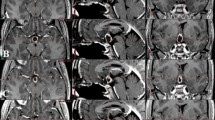Abstract
Objectives
The objective of the study is to compare survival and quality of life (QoL) by the delivery time of adjuvant radiotherapy (RT), early or late, for craniopharyngiomas.
Methods and materials
Fifty patients received RT between 1985 and 2002. Early RT (n=25) was delivered within 3 months after initial surgery, whereas late RT (n=25) was combined with or without reoperation after progression or relapse. Radiation dose ranged from 45 to 55.8 Gy with a median of 54 Gy. The median follow-up was 130 months.
Results
Progression-free survival rates at 5 and 10 years were 95.9 and 91.2%, respectively. The overall or progression-free survival was not influenced by RT time. Initial tumor size was the only prognostic factor (p=0.034) for progression-free survival in univariate analysis. Better visual acuity or field was maintained, and diabetes insipidus was partly improved with early RT, but all were deteriorated as tumor progressed without early RT. Visual functions were not worsened after late RT.
Conclusions
The survival was excellent with adjuvant RT, early or late. Poor QoL with late RT resulted from relapsed tumor and repeated surgery but was not associated with RT itself. Thus, early RT with precision technique is highly recommended for better QoL and excellent survival, unless contraindicated.






Similar content being viewed by others
References
Bunin GR, Surawicz TS, Witman PA et al (1998) The descriptive epidemiology of craniopharyngioma. J Neurosurg 89:547–551
Miller DC (1994) Pathology of craniopharyngiomas: clinical import of pathological findings. Pediatr Neurosurg 21(Suppl 1):11–17
Hoff JT, Patterson RH Jr (1972) Craniopharyngiomas in children and adults. J Neurosurg 36:299–302
Shapiro K, Till K, Grant DN (1979) Craniopharyngiomas in childhood: a rational approach to treatment. J Neurosurg 50:617–623
Hoffman HJ, Silva MD, Humphreys RP, Drake JM, Smith ML, Blaser SI (1992) Aggressive surgical management of craniopharyngiomas in children. J Neurosurg 76:47–52
Wen BW, Hussey DH, Staples J et al (1989) A comparison of the roles of surgery and radiation therapy in the management of craniopharyngiomas. Int J Radiat Oncol Biol Phys 16:17–24
Weiss M, Sutton L, Marcial V et al (1989) The role of radiation therapy in the management of childhood craniopharyngioma. Int J Radiat Oncol Biol Phys 17:1313–1321
Hetelekidis S, Barnes PD, Tao ML et al (1993) 20-year experience in childhood craniopharyngioma. Int J Radiat Oncol Biol Phys 27:189–195
Stripp DC, Maity A, Janss AJ et al (2004) Surgery with or without radiation therapy in the management of craniopharyngiomas in children and young adults. Int J Radiat Oncol Biol Phys 58:714–720
Shin KH, Yun HG, Kim IH, Park CI, Cho BK (1993) Postoperative radiation therapy of craniopharyngioma. J Korean Soc Ther Radiol 11:59–67
Silber JH, Radcliffe J, Peckham V et al (1992) Whole-brain irradiation and decline in intelligence: the influence of dose and age on IQ score. J Clin Oncol 10:1390–1396
Kitanaka C, Shitara N, Nakagomi T et al (1989) Postradiation astrocytoma: report of two cases. J Neurosurg 70:469–474
Yarsagil MG, Curcic M, Kis M et al (1990) Total removal of craniopharyngiomas. Approaches and long-term results in 144 patients. J Neurosurg 73:3–11
Hoffman HJ (1994) Surgical management of craniopharyngioma. Pediatr Neurosurg 21(Suppl 1):44–49
Habrand JL et al (1999) The role of radiation therapy in the management of craniopharyngioma: a 25-year experience and review of the literature. Int J Radiat Oncol Biol Phys 44:255–263
Kahn AP, Rose CS, Renier D (1994) Surgical approach to children with craniopharyngiomas and severely impaired vision: special consideration. Pediatr Neurosurg 21(Suppl 1):50–56
Baskin DS, Wilson CB (1985) Surgical management of craniopharyngioma. A review of 74 cases. J Neurosurg 65:22–27
Cavazzuti V, Fischer EG, Welch K, Belli JA, Winston KR et al (1983) Neurological and psychophysiological sequelae following different treatment of craniopharyngioma in children. J Neurosurg 59:409–417
Author information
Authors and Affiliations
Corresponding author
Rights and permissions
About this article
Cite this article
Moon, S.H., Kim, I.H., Park, S.W. et al. Early adjuvant radiotherapy toward long-term survival and better quality of life for craniopharyngiomas—a study in single institute. Childs Nerv Syst 21, 799–807 (2005). https://doi.org/10.1007/s00381-005-1189-2
Received:
Published:
Issue Date:
DOI: https://doi.org/10.1007/s00381-005-1189-2




